A feature article in our 2021 Late Winter Issue written by Edward Y. Morwick.
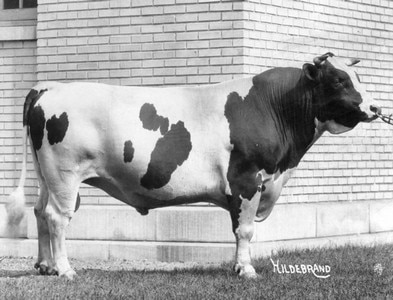
If you think that Brookview Tony Charity was the “be all and end all” of Holstein show cows, you had better take another look. It might come as a surprise that there was an Illinois cow as renowned in her era as Charity was in hers. In fact, in the early years of the 20th century this cow, who went by the name Minerva Beets, set a record that Charity, despite her best efforts, failed to equal.
Brookview Tony Charity was U.S. national champion (if a win at Madison counts as such) four times. She won the supreme award at Madison in 1982, 1984, 1985 and 1987. But she’ll have to stand down to Minerva Beets who was grand champion at the National Dairy Show on five occasions, in 1914, 1916, 1917, 1918 and 1919.
If there were a Mount Rushmore for Holstein showmen the first face would no doubt belong to Robert E. Haeger who happened to be Minerva’s owner. And at the end of the line, probably, would be a likeness of David John Brown. In an 18-year period (1986 to 2004) “Brownie” won a total of 92 All-American and All-Canadian awards, a record that has yet to be matched.
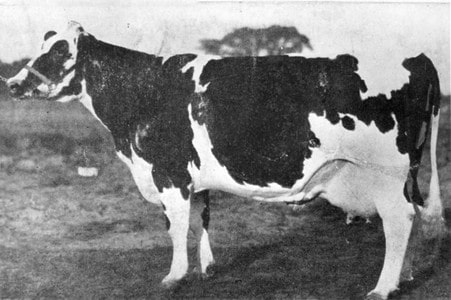
In Bob Haeger’s day there was no such thing as an All-American contest. Conformational superiority, in the United States at least, was measured by success at the National Dairy Show. At this exhibition Haeger put all others to shame, winning nine grand championships in the eleven years from 1909 to 1919. These nine purples were a record in the history of the show. Minerva Beets, as I’ve already said, was grand champion five times, while Paul Calamo Korndyke pulled down the National’s top prize in three consecutive years, a record that was not duplicated until 1928 when Sir Fobes Ormsby Hengerveld came along. Incidentally, the latter matched Minerva’s record when he won his fifth National grand championship in 1930.
Robert E. Haeger was born at Algonquin, Illinois on May 5, 1875. He grew up in a Holstein atmosphere. R.W. Haeger, his father, bought his first Holsteins in the year after his son’s birth, purchasing some purebreds from one of George E. Brown’s importations in the neighbouring town of Elgin.
When he was eight years of age, young Bob started out on the fair circuit with his father, never missing a year from 1883 to 1894. After some years as a professional baseball player – a newspaper of the time called him a “red-headed firebrand of a pitcher”, he returned to the home farm, put together a herd of show cows, and for a dozen years the Haeger herd burned up the big-time show circuits.
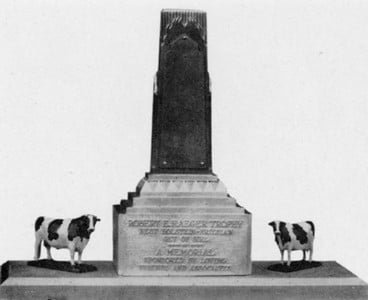
Bob Haeger made his first appearance at the National Dairy Show in 1909, coming away with two blue ribbons. In breeders’ minds, this 1909 event established the National as a permanent institution and the American nation’s most prestigious. It enjoyed patronage from across the United States and Canada and as time progressed, the honour of a win at the National was considered the fitting climax of a successful show season.
Haeger again made his presence felt in 1912 having three firsts to his credit, this being the first of three consecutive grand championships for his Paul Calamo Korndyke whom he had purchased for $250.00 at the Vandervoort Disperal in 1912. Haeger caught the brass ring again in 1913. In a show with eleven exhibitors from six states, Haeger took thirteen out of a possible twenty first prizes as well as both grand championships, Paul Calamo Korndyke claiming his second purple and Crescent Beauty Butter Maid, showing as a 4-year-old, topping the female section.
At the 1914 National, Haeger won both grand championships for the second time. The year marked the third and final championship for the veteran Paul Calamo Korndyke, a record that was not duplicated by any other bull until 1928 when Sir Fobes Ormsby Hengerveld won his third National grand championship. This too, was the year the Minerva Beets started the string of championships that she continued up to and including the 1919 show, a record unapproached by any other female.
No dairy show was held in 1915 on account of an outbreak of foot and mouth disease, but in the next year Haeger was again the big winner, exhibiting twelve first prize winners and winning the female grand championship with Minerva Beets. At the Nationals held at Columbus, Ohio in 1917 and 1918, “Minerva” continued her series of grand championships and Haeger, competing against the likes of Iowana, Carnation Farms and Chestnut & Sons, Kansas, won his fair share of blue ribbons, topping the get of sire class with a group by Paul Calamo Korndyke.
Dickinson & Son of Wisconsin were the leading winners at the 1919 National but were closely pressed by Haeger, whose Minerva Beets here closed her show ring career with her fifth grand championship. That 1919 exhibition was Haeger’s last appearance at the National Dairy Show.
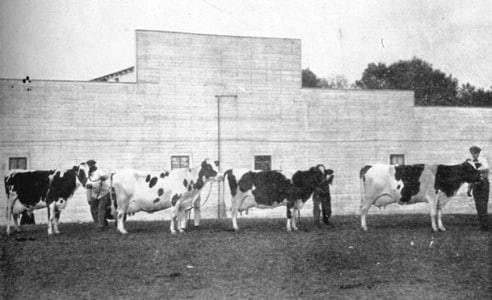
Haeger the sales manager
Bob Haeger, although the winningest showman of his generation, in later years devoted most of his time to sales management. Having sold sales locally for several years, he entered the big time in 1908 by teaming up with Barney Kelley in the management of the C.F. Hunt sale at Liverpool, N.Y. The sale averaged $129.00 for 69 head with a $500.00 top which earned it prominent mention in the Holstein-Friesian World. J.E. “Gene” Mack joined Kelly and Haeger in 1910 and they became the most famous selling trio in all of Holstein history. Kelly, Haeger and Mack were fixtures at every national sale event, East or West, until Kelley retired in 1920. Haeger, who at that point was probably the best-known auctioneer in the land, joined forces with W.L. Baird and Francis Darcey. The year 1926 marked the beginning of the annual National Blue Ribbon Sales under their management. On Haeger’s death, the firm of Baird & Darcey continued with these sales.
As a show ring judge, Haeger officiated at most of the important shows in the United States and Canada. He also served as a member of the True Type Committee of the Holstein-Friesian Association of America which gave expression to the ideal Holstein type in creating models of the perfect cow and bull.
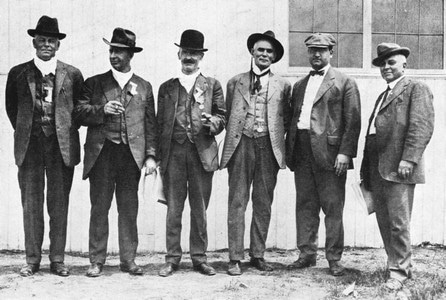
George Baxter, Bob Haeger, Barney Kelly, D.L. Perry, S.T. Wood and H.A. Moyer. Photo made at one of the famed Moyer National Sales.
As he passed his fifty-year mark, Haeger’s health deteriorated. He suffered from severe arthritis attacks and in 1930 sustained a severely broken leg which failed to heal properly. Neuritis, angina pectoris and other complications hastened his end. Haeger’s courage and indomitable spirit were shown in 1931 when he went to Detroit for the Royal Brentwood Sale with one crutch and a cane. Although too crippled to work in the ring, he sold nearly the whole sale from a chair in the auctioneer’s box. He passed away a year later, on August 12, 1932.
“Bob Haeger’s ready wit and keen humour brought sunshine into many a sale,” said his Holstein World obituary, “and brightened many a dark spot for countless friends. Bob Haeger believed that the way to have friends was to be one. He proved the soundness of this belief in his everyday life.”
